Detailed Report: Adult Care Requirements, Inspection, and Regulations
VerifiedAdded on 2022/12/28
|16
|5228
|76
Report
AI Summary
This report provides a comprehensive overview of the adult social care system in England, focusing on the key drivers and reasons for the inspection system. It outlines the regulatory framework, including the role of the Care Quality Commission (CQC), and the types of organizations subject to registration and inspection. The report compares the fundamental standards of safety and quality across various care provisions, such as safe, effective, caring, and person-centered care. It identifies key areas of inquiry for inspection, including registration, monitoring, and enforcement, and evaluates their impact on organizations. The grading system used in inspections, ranging from excellent to unsatisfactory, is explained, along with the implications of each grade. The report also examines the links between legislation and the inspection system and the standards of safety and quality across different care provisions.
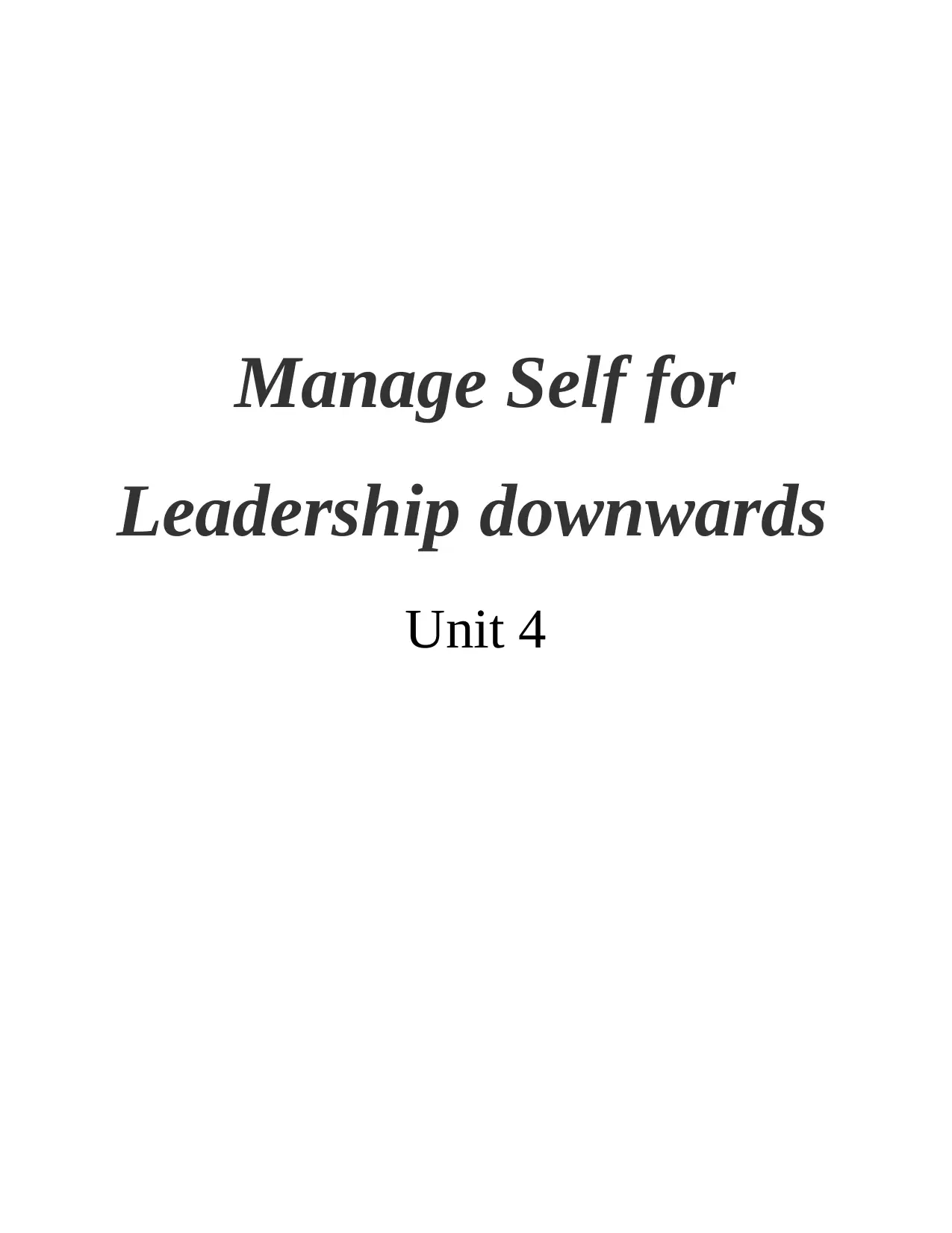
Manage Self for
Leadership downwards
Unit 4
Leadership downwards
Unit 4
Paraphrase This Document
Need a fresh take? Get an instant paraphrase of this document with our AI Paraphraser
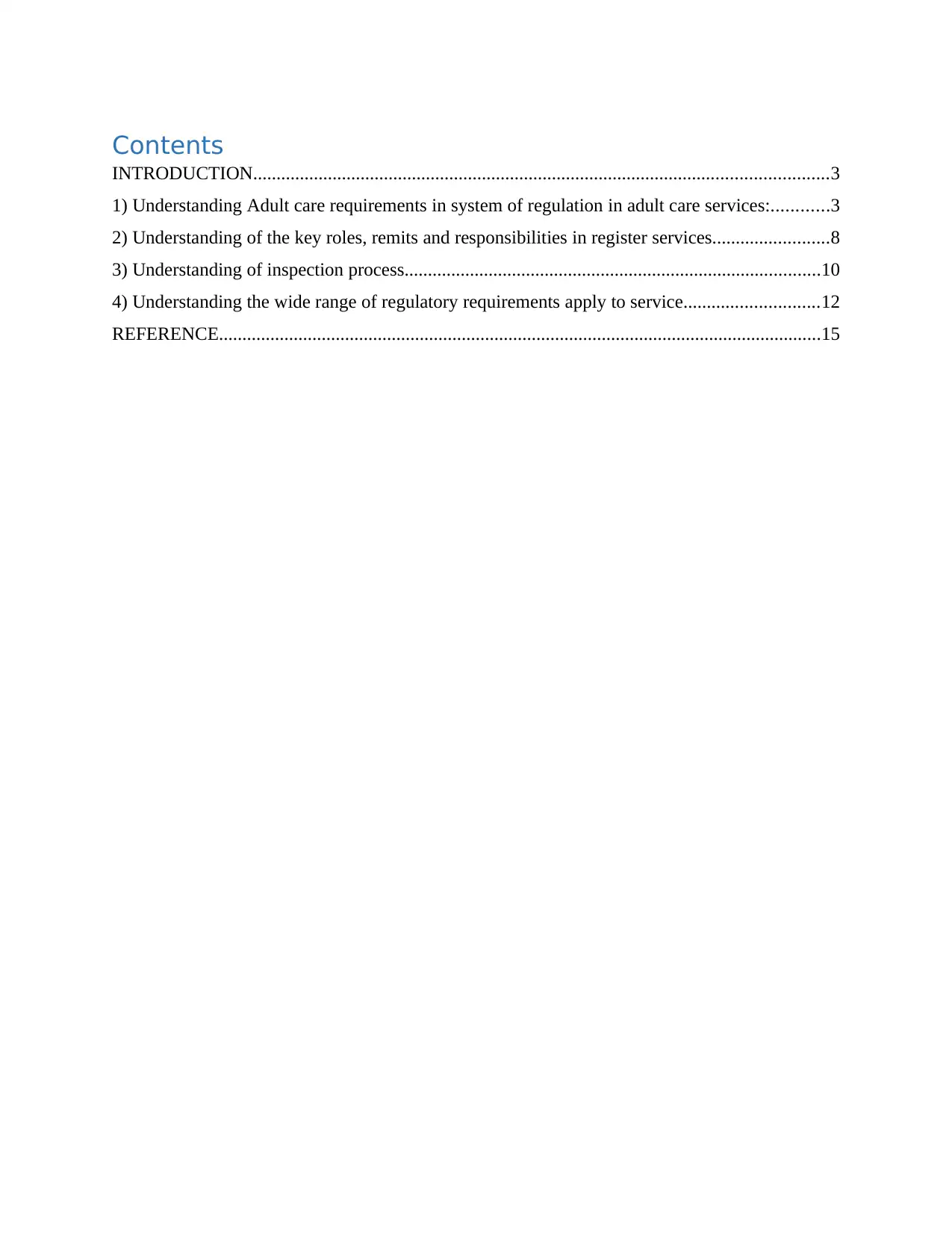
Contents
INTRODUCTION...........................................................................................................................3
1) Understanding Adult care requirements in system of regulation in adult care services:............3
2) Understanding of the key roles, remits and responsibilities in register services.........................8
3) Understanding of inspection process.........................................................................................10
4) Understanding the wide range of regulatory requirements apply to service.............................12
REFERENCE.................................................................................................................................15
INTRODUCTION...........................................................................................................................3
1) Understanding Adult care requirements in system of regulation in adult care services:............3
2) Understanding of the key roles, remits and responsibilities in register services.........................8
3) Understanding of inspection process.........................................................................................10
4) Understanding the wide range of regulatory requirements apply to service.............................12
REFERENCE.................................................................................................................................15
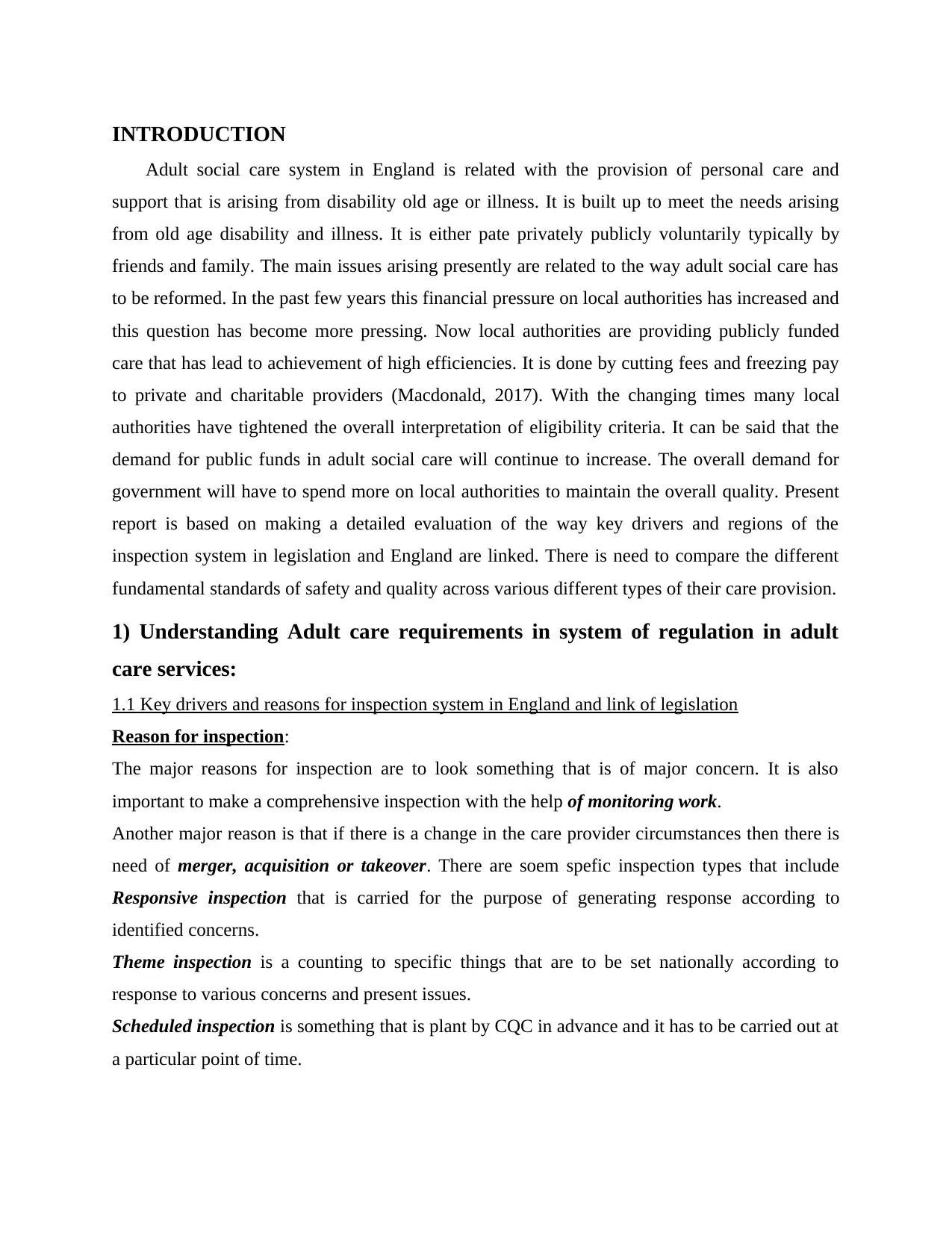
INTRODUCTION
Adult social care system in England is related with the provision of personal care and
support that is arising from disability old age or illness. It is built up to meet the needs arising
from old age disability and illness. It is either pate privately publicly voluntarily typically by
friends and family. The main issues arising presently are related to the way adult social care has
to be reformed. In the past few years this financial pressure on local authorities has increased and
this question has become more pressing. Now local authorities are providing publicly funded
care that has lead to achievement of high efficiencies. It is done by cutting fees and freezing pay
to private and charitable providers (Macdonald, 2017). With the changing times many local
authorities have tightened the overall interpretation of eligibility criteria. It can be said that the
demand for public funds in adult social care will continue to increase. The overall demand for
government will have to spend more on local authorities to maintain the overall quality. Present
report is based on making a detailed evaluation of the way key drivers and regions of the
inspection system in legislation and England are linked. There is need to compare the different
fundamental standards of safety and quality across various different types of their care provision.
1) Understanding Adult care requirements in system of regulation in adult
care services:
1.1 Key drivers and reasons for inspection system in England and link of legislation
Reason for inspection:
The major reasons for inspection are to look something that is of major concern. It is also
important to make a comprehensive inspection with the help of monitoring work.
Another major reason is that if there is a change in the care provider circumstances then there is
need of merger, acquisition or takeover. There are soem spefic inspection types that include
Responsive inspection that is carried for the purpose of generating response according to
identified concerns.
Theme inspection is a counting to specific things that are to be set nationally according to
response to various concerns and present issues.
Scheduled inspection is something that is plant by CQC in advance and it has to be carried out at
a particular point of time.
Adult social care system in England is related with the provision of personal care and
support that is arising from disability old age or illness. It is built up to meet the needs arising
from old age disability and illness. It is either pate privately publicly voluntarily typically by
friends and family. The main issues arising presently are related to the way adult social care has
to be reformed. In the past few years this financial pressure on local authorities has increased and
this question has become more pressing. Now local authorities are providing publicly funded
care that has lead to achievement of high efficiencies. It is done by cutting fees and freezing pay
to private and charitable providers (Macdonald, 2017). With the changing times many local
authorities have tightened the overall interpretation of eligibility criteria. It can be said that the
demand for public funds in adult social care will continue to increase. The overall demand for
government will have to spend more on local authorities to maintain the overall quality. Present
report is based on making a detailed evaluation of the way key drivers and regions of the
inspection system in legislation and England are linked. There is need to compare the different
fundamental standards of safety and quality across various different types of their care provision.
1) Understanding Adult care requirements in system of regulation in adult
care services:
1.1 Key drivers and reasons for inspection system in England and link of legislation
Reason for inspection:
The major reasons for inspection are to look something that is of major concern. It is also
important to make a comprehensive inspection with the help of monitoring work.
Another major reason is that if there is a change in the care provider circumstances then there is
need of merger, acquisition or takeover. There are soem spefic inspection types that include
Responsive inspection that is carried for the purpose of generating response according to
identified concerns.
Theme inspection is a counting to specific things that are to be set nationally according to
response to various concerns and present issues.
Scheduled inspection is something that is plant by CQC in advance and it has to be carried out at
a particular point of time.
⊘ This is a preview!⊘
Do you want full access?
Subscribe today to unlock all pages.

Trusted by 1+ million students worldwide
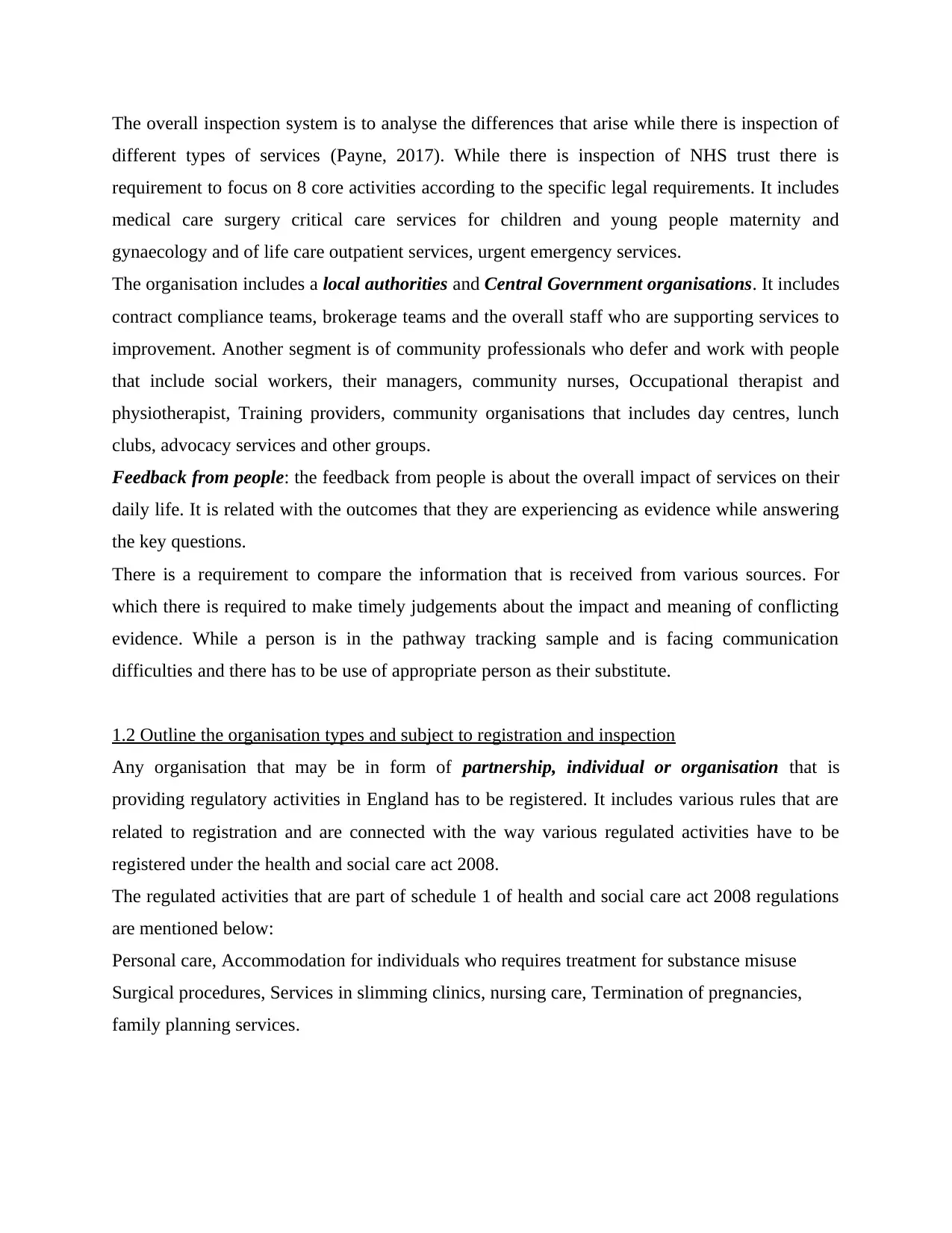
The overall inspection system is to analyse the differences that arise while there is inspection of
different types of services (Payne, 2017). While there is inspection of NHS trust there is
requirement to focus on 8 core activities according to the specific legal requirements. It includes
medical care surgery critical care services for children and young people maternity and
gynaecology and of life care outpatient services, urgent emergency services.
The organisation includes a local authorities and Central Government organisations. It includes
contract compliance teams, brokerage teams and the overall staff who are supporting services to
improvement. Another segment is of community professionals who defer and work with people
that include social workers, their managers, community nurses, Occupational therapist and
physiotherapist, Training providers, community organisations that includes day centres, lunch
clubs, advocacy services and other groups.
Feedback from people: the feedback from people is about the overall impact of services on their
daily life. It is related with the outcomes that they are experiencing as evidence while answering
the key questions.
There is a requirement to compare the information that is received from various sources. For
which there is required to make timely judgements about the impact and meaning of conflicting
evidence. While a person is in the pathway tracking sample and is facing communication
difficulties and there has to be use of appropriate person as their substitute.
1.2 Outline the organisation types and subject to registration and inspection
Any organisation that may be in form of partnership, individual or organisation that is
providing regulatory activities in England has to be registered. It includes various rules that are
related to registration and are connected with the way various regulated activities have to be
registered under the health and social care act 2008.
The regulated activities that are part of schedule 1 of health and social care act 2008 regulations
are mentioned below:
Personal care, Accommodation for individuals who requires treatment for substance misuse
Surgical procedures, Services in slimming clinics, nursing care, Termination of pregnancies,
family planning services.
different types of services (Payne, 2017). While there is inspection of NHS trust there is
requirement to focus on 8 core activities according to the specific legal requirements. It includes
medical care surgery critical care services for children and young people maternity and
gynaecology and of life care outpatient services, urgent emergency services.
The organisation includes a local authorities and Central Government organisations. It includes
contract compliance teams, brokerage teams and the overall staff who are supporting services to
improvement. Another segment is of community professionals who defer and work with people
that include social workers, their managers, community nurses, Occupational therapist and
physiotherapist, Training providers, community organisations that includes day centres, lunch
clubs, advocacy services and other groups.
Feedback from people: the feedback from people is about the overall impact of services on their
daily life. It is related with the outcomes that they are experiencing as evidence while answering
the key questions.
There is a requirement to compare the information that is received from various sources. For
which there is required to make timely judgements about the impact and meaning of conflicting
evidence. While a person is in the pathway tracking sample and is facing communication
difficulties and there has to be use of appropriate person as their substitute.
1.2 Outline the organisation types and subject to registration and inspection
Any organisation that may be in form of partnership, individual or organisation that is
providing regulatory activities in England has to be registered. It includes various rules that are
related to registration and are connected with the way various regulated activities have to be
registered under the health and social care act 2008.
The regulated activities that are part of schedule 1 of health and social care act 2008 regulations
are mentioned below:
Personal care, Accommodation for individuals who requires treatment for substance misuse
Surgical procedures, Services in slimming clinics, nursing care, Termination of pregnancies,
family planning services.
Paraphrase This Document
Need a fresh take? Get an instant paraphrase of this document with our AI Paraphraser
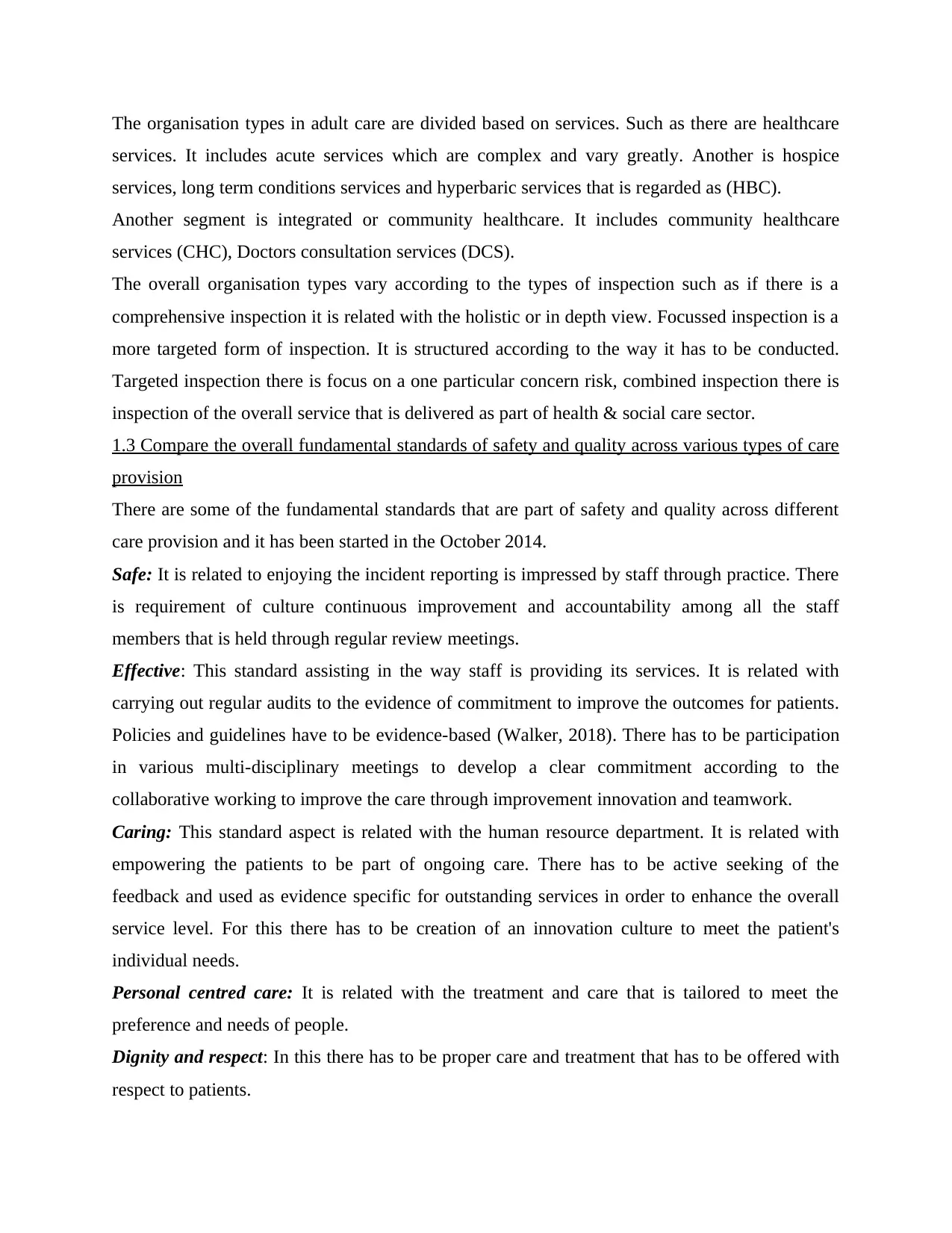
The organisation types in adult care are divided based on services. Such as there are healthcare
services. It includes acute services which are complex and vary greatly. Another is hospice
services, long term conditions services and hyperbaric services that is regarded as (HBC).
Another segment is integrated or community healthcare. It includes community healthcare
services (CHC), Doctors consultation services (DCS).
The overall organisation types vary according to the types of inspection such as if there is a
comprehensive inspection it is related with the holistic or in depth view. Focussed inspection is a
more targeted form of inspection. It is structured according to the way it has to be conducted.
Targeted inspection there is focus on a one particular concern risk, combined inspection there is
inspection of the overall service that is delivered as part of health & social care sector.
1.3 Compare the overall fundamental standards of safety and quality across various types of care
provision
There are some of the fundamental standards that are part of safety and quality across different
care provision and it has been started in the October 2014.
Safe: It is related to enjoying the incident reporting is impressed by staff through practice. There
is requirement of culture continuous improvement and accountability among all the staff
members that is held through regular review meetings.
Effective: This standard assisting in the way staff is providing its services. It is related with
carrying out regular audits to the evidence of commitment to improve the outcomes for patients.
Policies and guidelines have to be evidence-based (Walker, 2018). There has to be participation
in various multi-disciplinary meetings to develop a clear commitment according to the
collaborative working to improve the care through improvement innovation and teamwork.
Caring: This standard aspect is related with the human resource department. It is related with
empowering the patients to be part of ongoing care. There has to be active seeking of the
feedback and used as evidence specific for outstanding services in order to enhance the overall
service level. For this there has to be creation of an innovation culture to meet the patient's
individual needs.
Personal centred care: It is related with the treatment and care that is tailored to meet the
preference and needs of people.
Dignity and respect: In this there has to be proper care and treatment that has to be offered with
respect to patients.
services. It includes acute services which are complex and vary greatly. Another is hospice
services, long term conditions services and hyperbaric services that is regarded as (HBC).
Another segment is integrated or community healthcare. It includes community healthcare
services (CHC), Doctors consultation services (DCS).
The overall organisation types vary according to the types of inspection such as if there is a
comprehensive inspection it is related with the holistic or in depth view. Focussed inspection is a
more targeted form of inspection. It is structured according to the way it has to be conducted.
Targeted inspection there is focus on a one particular concern risk, combined inspection there is
inspection of the overall service that is delivered as part of health & social care sector.
1.3 Compare the overall fundamental standards of safety and quality across various types of care
provision
There are some of the fundamental standards that are part of safety and quality across different
care provision and it has been started in the October 2014.
Safe: It is related to enjoying the incident reporting is impressed by staff through practice. There
is requirement of culture continuous improvement and accountability among all the staff
members that is held through regular review meetings.
Effective: This standard assisting in the way staff is providing its services. It is related with
carrying out regular audits to the evidence of commitment to improve the outcomes for patients.
Policies and guidelines have to be evidence-based (Walker, 2018). There has to be participation
in various multi-disciplinary meetings to develop a clear commitment according to the
collaborative working to improve the care through improvement innovation and teamwork.
Caring: This standard aspect is related with the human resource department. It is related with
empowering the patients to be part of ongoing care. There has to be active seeking of the
feedback and used as evidence specific for outstanding services in order to enhance the overall
service level. For this there has to be creation of an innovation culture to meet the patient's
individual needs.
Personal centred care: It is related with the treatment and care that is tailored to meet the
preference and needs of people.
Dignity and respect: In this there has to be proper care and treatment that has to be offered with
respect to patients.
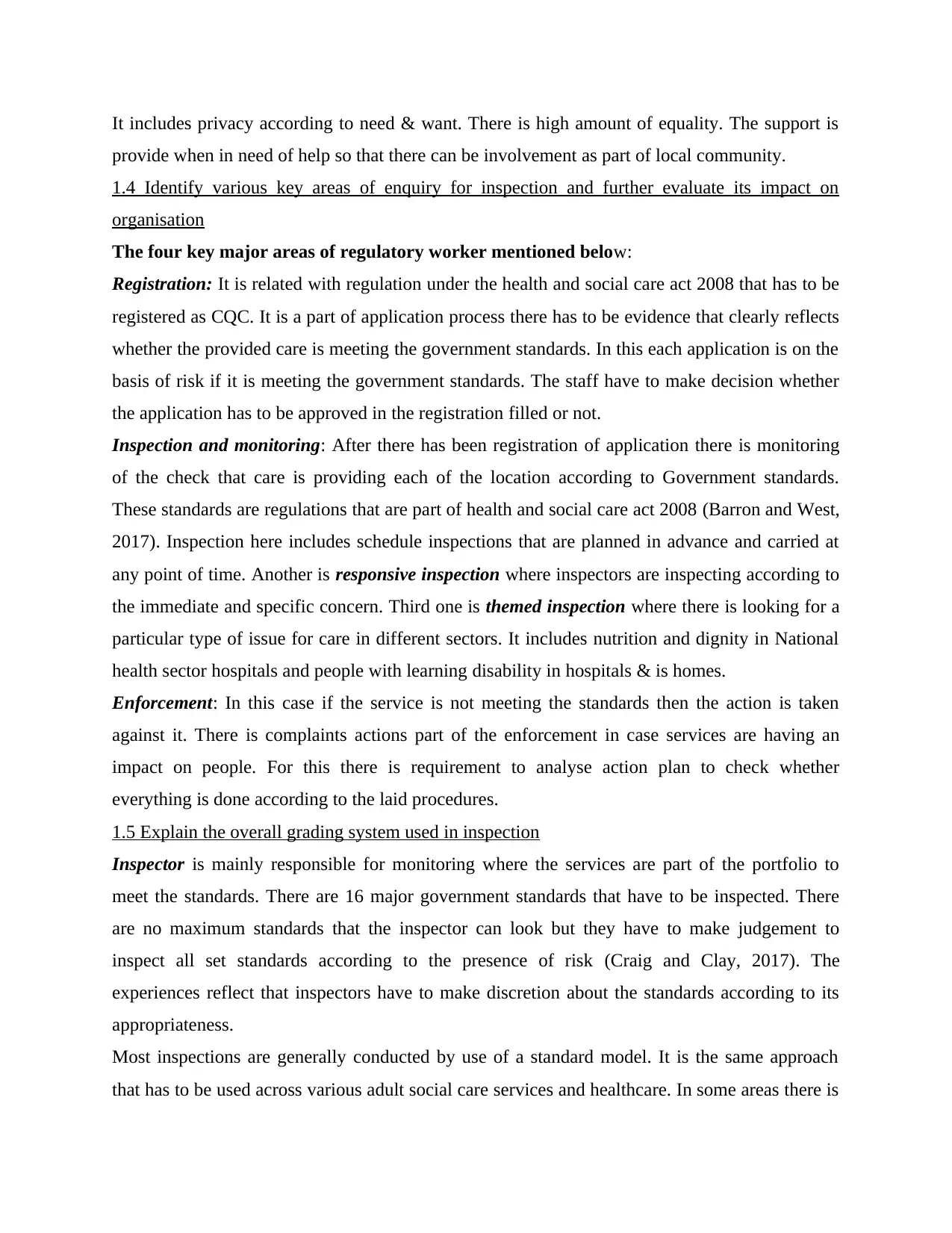
It includes privacy according to need & want. There is high amount of equality. The support is
provide when in need of help so that there can be involvement as part of local community.
1.4 Identify various key areas of enquiry for inspection and further evaluate its impact on
organisation
The four key major areas of regulatory worker mentioned below:
Registration: It is related with regulation under the health and social care act 2008 that has to be
registered as CQC. It is a part of application process there has to be evidence that clearly reflects
whether the provided care is meeting the government standards. In this each application is on the
basis of risk if it is meeting the government standards. The staff have to make decision whether
the application has to be approved in the registration filled or not.
Inspection and monitoring: After there has been registration of application there is monitoring
of the check that care is providing each of the location according to Government standards.
These standards are regulations that are part of health and social care act 2008 (Barron and West,
2017). Inspection here includes schedule inspections that are planned in advance and carried at
any point of time. Another is responsive inspection where inspectors are inspecting according to
the immediate and specific concern. Third one is themed inspection where there is looking for a
particular type of issue for care in different sectors. It includes nutrition and dignity in National
health sector hospitals and people with learning disability in hospitals & is homes.
Enforcement: In this case if the service is not meeting the standards then the action is taken
against it. There is complaints actions part of the enforcement in case services are having an
impact on people. For this there is requirement to analyse action plan to check whether
everything is done according to the laid procedures.
1.5 Explain the overall grading system used in inspection
Inspector is mainly responsible for monitoring where the services are part of the portfolio to
meet the standards. There are 16 major government standards that have to be inspected. There
are no maximum standards that the inspector can look but they have to make judgement to
inspect all set standards according to the presence of risk (Craig and Clay, 2017). The
experiences reflect that inspectors have to make discretion about the standards according to its
appropriateness.
Most inspections are generally conducted by use of a standard model. It is the same approach
that has to be used across various adult social care services and healthcare. In some areas there is
provide when in need of help so that there can be involvement as part of local community.
1.4 Identify various key areas of enquiry for inspection and further evaluate its impact on
organisation
The four key major areas of regulatory worker mentioned below:
Registration: It is related with regulation under the health and social care act 2008 that has to be
registered as CQC. It is a part of application process there has to be evidence that clearly reflects
whether the provided care is meeting the government standards. In this each application is on the
basis of risk if it is meeting the government standards. The staff have to make decision whether
the application has to be approved in the registration filled or not.
Inspection and monitoring: After there has been registration of application there is monitoring
of the check that care is providing each of the location according to Government standards.
These standards are regulations that are part of health and social care act 2008 (Barron and West,
2017). Inspection here includes schedule inspections that are planned in advance and carried at
any point of time. Another is responsive inspection where inspectors are inspecting according to
the immediate and specific concern. Third one is themed inspection where there is looking for a
particular type of issue for care in different sectors. It includes nutrition and dignity in National
health sector hospitals and people with learning disability in hospitals & is homes.
Enforcement: In this case if the service is not meeting the standards then the action is taken
against it. There is complaints actions part of the enforcement in case services are having an
impact on people. For this there is requirement to analyse action plan to check whether
everything is done according to the laid procedures.
1.5 Explain the overall grading system used in inspection
Inspector is mainly responsible for monitoring where the services are part of the portfolio to
meet the standards. There are 16 major government standards that have to be inspected. There
are no maximum standards that the inspector can look but they have to make judgement to
inspect all set standards according to the presence of risk (Craig and Clay, 2017). The
experiences reflect that inspectors have to make discretion about the standards according to its
appropriateness.
Most inspections are generally conducted by use of a standard model. It is the same approach
that has to be used across various adult social care services and healthcare. In some areas there is
⊘ This is a preview!⊘
Do you want full access?
Subscribe today to unlock all pages.

Trusted by 1+ million students worldwide
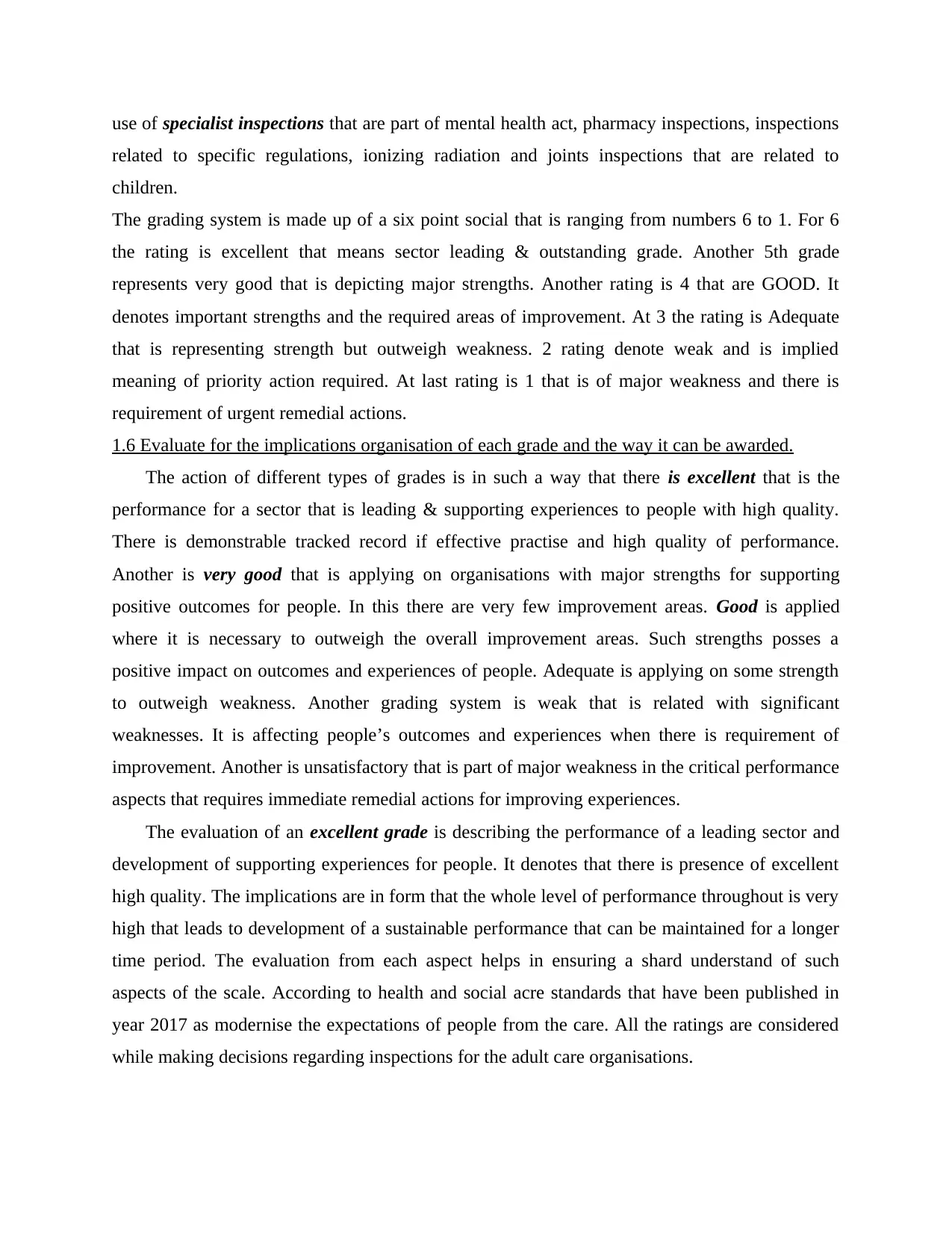
use of specialist inspections that are part of mental health act, pharmacy inspections, inspections
related to specific regulations, ionizing radiation and joints inspections that are related to
children.
The grading system is made up of a six point social that is ranging from numbers 6 to 1. For 6
the rating is excellent that means sector leading & outstanding grade. Another 5th grade
represents very good that is depicting major strengths. Another rating is 4 that are GOOD. It
denotes important strengths and the required areas of improvement. At 3 the rating is Adequate
that is representing strength but outweigh weakness. 2 rating denote weak and is implied
meaning of priority action required. At last rating is 1 that is of major weakness and there is
requirement of urgent remedial actions.
1.6 Evaluate for the implications organisation of each grade and the way it can be awarded.
The action of different types of grades is in such a way that there is excellent that is the
performance for a sector that is leading & supporting experiences to people with high quality.
There is demonstrable tracked record if effective practise and high quality of performance.
Another is very good that is applying on organisations with major strengths for supporting
positive outcomes for people. In this there are very few improvement areas. Good is applied
where it is necessary to outweigh the overall improvement areas. Such strengths posses a
positive impact on outcomes and experiences of people. Adequate is applying on some strength
to outweigh weakness. Another grading system is weak that is related with significant
weaknesses. It is affecting people’s outcomes and experiences when there is requirement of
improvement. Another is unsatisfactory that is part of major weakness in the critical performance
aspects that requires immediate remedial actions for improving experiences.
The evaluation of an excellent grade is describing the performance of a leading sector and
development of supporting experiences for people. It denotes that there is presence of excellent
high quality. The implications are in form that the whole level of performance throughout is very
high that leads to development of a sustainable performance that can be maintained for a longer
time period. The evaluation from each aspect helps in ensuring a shard understand of such
aspects of the scale. According to health and social acre standards that have been published in
year 2017 as modernise the expectations of people from the care. All the ratings are considered
while making decisions regarding inspections for the adult care organisations.
related to specific regulations, ionizing radiation and joints inspections that are related to
children.
The grading system is made up of a six point social that is ranging from numbers 6 to 1. For 6
the rating is excellent that means sector leading & outstanding grade. Another 5th grade
represents very good that is depicting major strengths. Another rating is 4 that are GOOD. It
denotes important strengths and the required areas of improvement. At 3 the rating is Adequate
that is representing strength but outweigh weakness. 2 rating denote weak and is implied
meaning of priority action required. At last rating is 1 that is of major weakness and there is
requirement of urgent remedial actions.
1.6 Evaluate for the implications organisation of each grade and the way it can be awarded.
The action of different types of grades is in such a way that there is excellent that is the
performance for a sector that is leading & supporting experiences to people with high quality.
There is demonstrable tracked record if effective practise and high quality of performance.
Another is very good that is applying on organisations with major strengths for supporting
positive outcomes for people. In this there are very few improvement areas. Good is applied
where it is necessary to outweigh the overall improvement areas. Such strengths posses a
positive impact on outcomes and experiences of people. Adequate is applying on some strength
to outweigh weakness. Another grading system is weak that is related with significant
weaknesses. It is affecting people’s outcomes and experiences when there is requirement of
improvement. Another is unsatisfactory that is part of major weakness in the critical performance
aspects that requires immediate remedial actions for improving experiences.
The evaluation of an excellent grade is describing the performance of a leading sector and
development of supporting experiences for people. It denotes that there is presence of excellent
high quality. The implications are in form that the whole level of performance throughout is very
high that leads to development of a sustainable performance that can be maintained for a longer
time period. The evaluation from each aspect helps in ensuring a shard understand of such
aspects of the scale. According to health and social acre standards that have been published in
year 2017 as modernise the expectations of people from the care. All the ratings are considered
while making decisions regarding inspections for the adult care organisations.
Paraphrase This Document
Need a fresh take? Get an instant paraphrase of this document with our AI Paraphraser
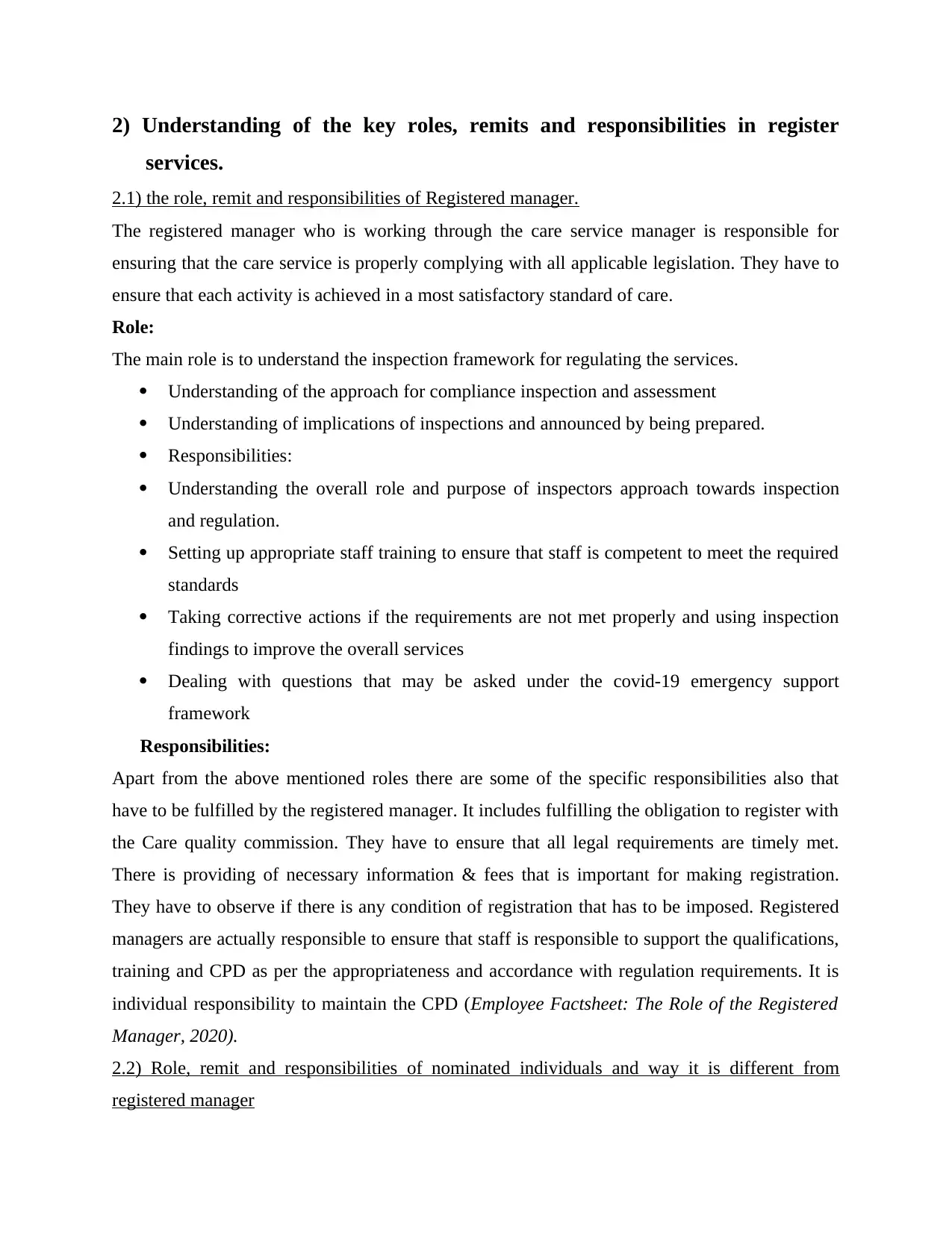
2) Understanding of the key roles, remits and responsibilities in register
services.
2.1) the role, remit and responsibilities of Registered manager.
The registered manager who is working through the care service manager is responsible for
ensuring that the care service is properly complying with all applicable legislation. They have to
ensure that each activity is achieved in a most satisfactory standard of care.
Role:
The main role is to understand the inspection framework for regulating the services.
Understanding of the approach for compliance inspection and assessment
Understanding of implications of inspections and announced by being prepared.
Responsibilities:
Understanding the overall role and purpose of inspectors approach towards inspection
and regulation.
Setting up appropriate staff training to ensure that staff is competent to meet the required
standards
Taking corrective actions if the requirements are not met properly and using inspection
findings to improve the overall services
Dealing with questions that may be asked under the covid-19 emergency support
framework
Responsibilities:
Apart from the above mentioned roles there are some of the specific responsibilities also that
have to be fulfilled by the registered manager. It includes fulfilling the obligation to register with
the Care quality commission. They have to ensure that all legal requirements are timely met.
There is providing of necessary information & fees that is important for making registration.
They have to observe if there is any condition of registration that has to be imposed. Registered
managers are actually responsible to ensure that staff is responsible to support the qualifications,
training and CPD as per the appropriateness and accordance with regulation requirements. It is
individual responsibility to maintain the CPD (Employee Factsheet: The Role of the Registered
Manager, 2020).
2.2) Role, remit and responsibilities of nominated individuals and way it is different from
registered manager
services.
2.1) the role, remit and responsibilities of Registered manager.
The registered manager who is working through the care service manager is responsible for
ensuring that the care service is properly complying with all applicable legislation. They have to
ensure that each activity is achieved in a most satisfactory standard of care.
Role:
The main role is to understand the inspection framework for regulating the services.
Understanding of the approach for compliance inspection and assessment
Understanding of implications of inspections and announced by being prepared.
Responsibilities:
Understanding the overall role and purpose of inspectors approach towards inspection
and regulation.
Setting up appropriate staff training to ensure that staff is competent to meet the required
standards
Taking corrective actions if the requirements are not met properly and using inspection
findings to improve the overall services
Dealing with questions that may be asked under the covid-19 emergency support
framework
Responsibilities:
Apart from the above mentioned roles there are some of the specific responsibilities also that
have to be fulfilled by the registered manager. It includes fulfilling the obligation to register with
the Care quality commission. They have to ensure that all legal requirements are timely met.
There is providing of necessary information & fees that is important for making registration.
They have to observe if there is any condition of registration that has to be imposed. Registered
managers are actually responsible to ensure that staff is responsible to support the qualifications,
training and CPD as per the appropriateness and accordance with regulation requirements. It is
individual responsibility to maintain the CPD (Employee Factsheet: The Role of the Registered
Manager, 2020).
2.2) Role, remit and responsibilities of nominated individuals and way it is different from
registered manager
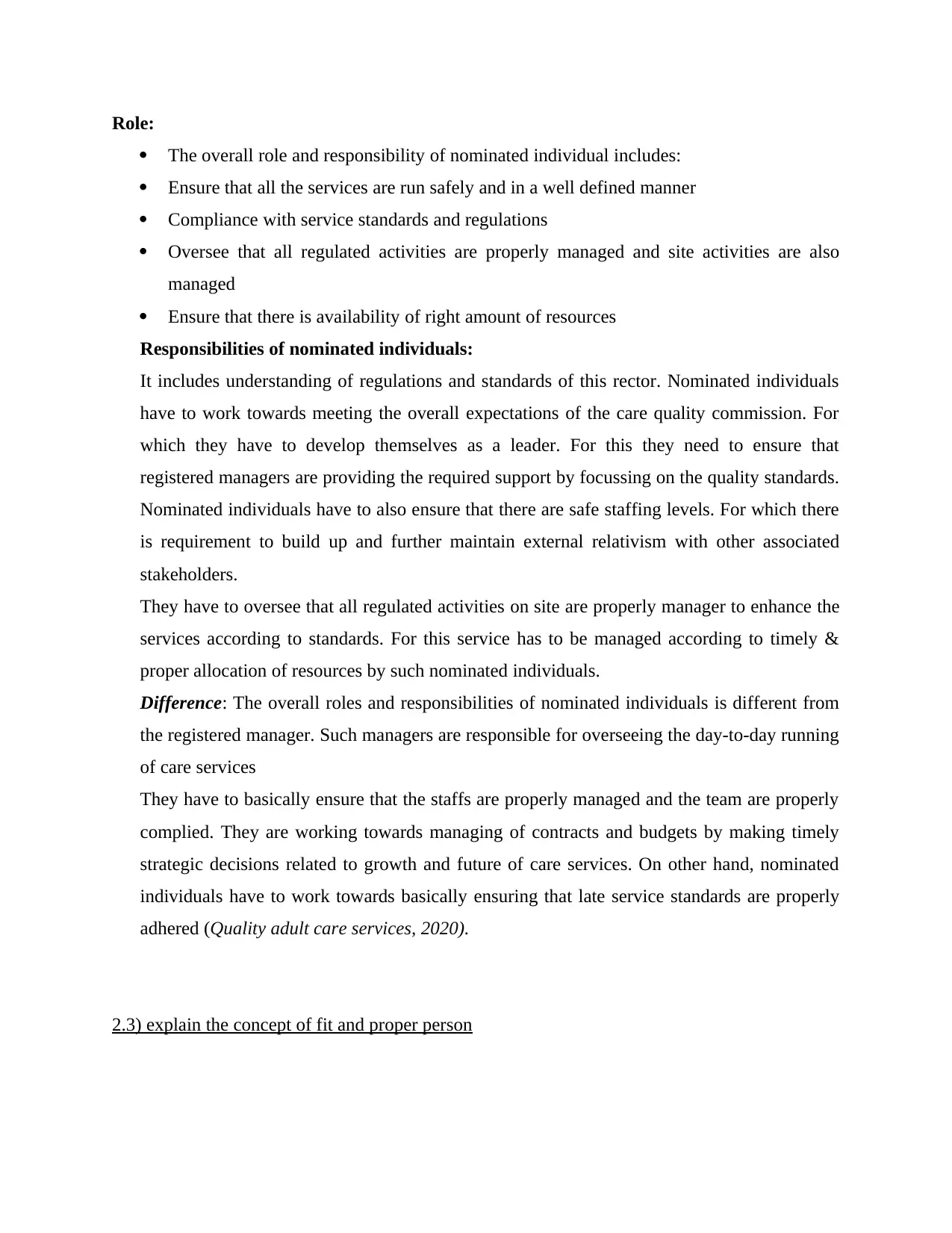
Role:
The overall role and responsibility of nominated individual includes:
Ensure that all the services are run safely and in a well defined manner
Compliance with service standards and regulations
Oversee that all regulated activities are properly managed and site activities are also
managed
Ensure that there is availability of right amount of resources
Responsibilities of nominated individuals:
It includes understanding of regulations and standards of this rector. Nominated individuals
have to work towards meeting the overall expectations of the care quality commission. For
which they have to develop themselves as a leader. For this they need to ensure that
registered managers are providing the required support by focussing on the quality standards.
Nominated individuals have to also ensure that there are safe staffing levels. For which there
is requirement to build up and further maintain external relativism with other associated
stakeholders.
They have to oversee that all regulated activities on site are properly manager to enhance the
services according to standards. For this service has to be managed according to timely &
proper allocation of resources by such nominated individuals.
Difference: The overall roles and responsibilities of nominated individuals is different from
the registered manager. Such managers are responsible for overseeing the day-to-day running
of care services
They have to basically ensure that the staffs are properly managed and the team are properly
complied. They are working towards managing of contracts and budgets by making timely
strategic decisions related to growth and future of care services. On other hand, nominated
individuals have to work towards basically ensuring that late service standards are properly
adhered (Quality adult care services, 2020).
2.3) explain the concept of fit and proper person
The overall role and responsibility of nominated individual includes:
Ensure that all the services are run safely and in a well defined manner
Compliance with service standards and regulations
Oversee that all regulated activities are properly managed and site activities are also
managed
Ensure that there is availability of right amount of resources
Responsibilities of nominated individuals:
It includes understanding of regulations and standards of this rector. Nominated individuals
have to work towards meeting the overall expectations of the care quality commission. For
which they have to develop themselves as a leader. For this they need to ensure that
registered managers are providing the required support by focussing on the quality standards.
Nominated individuals have to also ensure that there are safe staffing levels. For which there
is requirement to build up and further maintain external relativism with other associated
stakeholders.
They have to oversee that all regulated activities on site are properly manager to enhance the
services according to standards. For this service has to be managed according to timely &
proper allocation of resources by such nominated individuals.
Difference: The overall roles and responsibilities of nominated individuals is different from
the registered manager. Such managers are responsible for overseeing the day-to-day running
of care services
They have to basically ensure that the staffs are properly managed and the team are properly
complied. They are working towards managing of contracts and budgets by making timely
strategic decisions related to growth and future of care services. On other hand, nominated
individuals have to work towards basically ensuring that late service standards are properly
adhered (Quality adult care services, 2020).
2.3) explain the concept of fit and proper person
⊘ This is a preview!⊘
Do you want full access?
Subscribe today to unlock all pages.

Trusted by 1+ million students worldwide

The concept of fit and proper person is to ensure that there is meeting up of certain health
requirements. It includes making necessary adjustments under the equality act 2010 to ensure
that there are no disabilities or impairments that may be a hurdle in carrying the work
Organisation makes enough checks to ensure that the appointee is not meeting any of the criteria
that are in part 1 of schedule 4 after regulations. Regulation 5 is applying to all directors and not
also two new appointments where they have to continue to meet all the fitness test in office (Fit
and proper person requirements, 2020).
The proper person is defined as an individual holding a good character (Pritchard, 2020). It
denotes that person has not been convicted in United Kingdom of any type of offence. Another
criterion is that the person must maintain a regulator of health care and social work professionals.
They are able to supply information that is part of schedule III in the regulations. A fit and
proper person has not been responsible to contribute to any type of serious misconduct or Ms
Management in the course of carrying a regulated activity or in situations of providing services.
The intention of fit & proper person regulation (FPPR) is to ensure that the people who have
director level responsibility is according to the safety and quality of care, support and treatment
to carry out their assigned roles. For this there is need to vary out timely checks and make sure
that a particular individual is suitable for a specified role (THE FIT AND PROPER PERSONS
REGULATIONS, 2020).
3) Understanding of inspection process
3.1) Explain the need to be aware of inspection process
Workplace inspections are very necessary for preventing injuries illness and incidents.
Comprehensive inspections are very necessary for providing a holistic and in-depth view across
the whole services. It helps in getting a look of all the questions that are important to ensure that
the services are effective responsive caring safe and well led. It also helps in getting a rating of
outstanding or improvement in each of the question according to the process of inspection.
It is very necessary to understand the overall importance of inspection process as it provides the
two insights of services (Johannsen, Senger and Kluss, 2021). In year 2014, skills for care are
delivering seminars to standard the overall adult social care services. There are different
registered managers who are working towards developing a good force to meet the regulations.
In 2017 CQC as reported significant number of new care providers who are fail to meet the
overall standards of first inspection. It has highlighted the importance of new services that is
requirements. It includes making necessary adjustments under the equality act 2010 to ensure
that there are no disabilities or impairments that may be a hurdle in carrying the work
Organisation makes enough checks to ensure that the appointee is not meeting any of the criteria
that are in part 1 of schedule 4 after regulations. Regulation 5 is applying to all directors and not
also two new appointments where they have to continue to meet all the fitness test in office (Fit
and proper person requirements, 2020).
The proper person is defined as an individual holding a good character (Pritchard, 2020). It
denotes that person has not been convicted in United Kingdom of any type of offence. Another
criterion is that the person must maintain a regulator of health care and social work professionals.
They are able to supply information that is part of schedule III in the regulations. A fit and
proper person has not been responsible to contribute to any type of serious misconduct or Ms
Management in the course of carrying a regulated activity or in situations of providing services.
The intention of fit & proper person regulation (FPPR) is to ensure that the people who have
director level responsibility is according to the safety and quality of care, support and treatment
to carry out their assigned roles. For this there is need to vary out timely checks and make sure
that a particular individual is suitable for a specified role (THE FIT AND PROPER PERSONS
REGULATIONS, 2020).
3) Understanding of inspection process
3.1) Explain the need to be aware of inspection process
Workplace inspections are very necessary for preventing injuries illness and incidents.
Comprehensive inspections are very necessary for providing a holistic and in-depth view across
the whole services. It helps in getting a look of all the questions that are important to ensure that
the services are effective responsive caring safe and well led. It also helps in getting a rating of
outstanding or improvement in each of the question according to the process of inspection.
It is very necessary to understand the overall importance of inspection process as it provides the
two insights of services (Johannsen, Senger and Kluss, 2021). In year 2014, skills for care are
delivering seminars to standard the overall adult social care services. There are different
registered managers who are working towards developing a good force to meet the regulations.
In 2017 CQC as reported significant number of new care providers who are fail to meet the
overall standards of first inspection. It has highlighted the importance of new services that is
Paraphrase This Document
Need a fresh take? Get an instant paraphrase of this document with our AI Paraphraser

prepared for inspection. Sometimes poor inspection rating can result into a negative impact on
the present public image .It may lead to a pessimistic crash on the new services. It can also lead
towards a harmful impact on damaging if it comes from an existing profile of Adult care.
Inspection process is very important so that there can be development of a detail in-depth view
of the overall services that are being offered. It required evaluating the rating that actually
describes the situation of a particular organisation and its level of services.
3.2) Explain who is part of inspection process
Managers and leaders are very important part for the success of organisation. Effective
induction of managers is a key focus for the right step and in the right direction. There are some
of the standards that are part of first step to equip new and some of the aspiring managers to
perform well in the respective roles (What Is The Role Of Responsible And Nominated
Individuals?, 2020).
It includes lead inspector who is actually leading the whole inspection work. He is the one who
is assigning roles & responsibilities to various team members and their inspection team. Apart
from this registered manager have to assist lead inspector in performing their roles. They have
to follow up for additional visits. Apart from this other member staff is subordinates to both
lead inspector and register manager who have to work according to directions provided by them
in course of whole functioning.
They are various methods that can be used to reflect the good practice to be used for the purpose
of inspection. It includes job consultants, team meetings and appraisals with every timescales
considerable planning and proper supervision that have to be rules specific (Heenan, and Birrell,
2017). The overall inspection of services is related to comprehensive inspection. In this the
inspector has to review the overall information about the service and contact that is very relevant
for professionals and stakeholders. Focus inspection is related with following the same process
and using of similar methods to specific key questions.
After the inspection is halfway completed the lead inspector has to meet the registered manager
and other staff members for providing the necessary feedback.
This feedback will include the analysis of evidence before there can be reaching to final
judgements of ratings and issues.
3.3) Evaluate the way to address outcomes and it’s impact on inspection
the present public image .It may lead to a pessimistic crash on the new services. It can also lead
towards a harmful impact on damaging if it comes from an existing profile of Adult care.
Inspection process is very important so that there can be development of a detail in-depth view
of the overall services that are being offered. It required evaluating the rating that actually
describes the situation of a particular organisation and its level of services.
3.2) Explain who is part of inspection process
Managers and leaders are very important part for the success of organisation. Effective
induction of managers is a key focus for the right step and in the right direction. There are some
of the standards that are part of first step to equip new and some of the aspiring managers to
perform well in the respective roles (What Is The Role Of Responsible And Nominated
Individuals?, 2020).
It includes lead inspector who is actually leading the whole inspection work. He is the one who
is assigning roles & responsibilities to various team members and their inspection team. Apart
from this registered manager have to assist lead inspector in performing their roles. They have
to follow up for additional visits. Apart from this other member staff is subordinates to both
lead inspector and register manager who have to work according to directions provided by them
in course of whole functioning.
They are various methods that can be used to reflect the good practice to be used for the purpose
of inspection. It includes job consultants, team meetings and appraisals with every timescales
considerable planning and proper supervision that have to be rules specific (Heenan, and Birrell,
2017). The overall inspection of services is related to comprehensive inspection. In this the
inspector has to review the overall information about the service and contact that is very relevant
for professionals and stakeholders. Focus inspection is related with following the same process
and using of similar methods to specific key questions.
After the inspection is halfway completed the lead inspector has to meet the registered manager
and other staff members for providing the necessary feedback.
This feedback will include the analysis of evidence before there can be reaching to final
judgements of ratings and issues.
3.3) Evaluate the way to address outcomes and it’s impact on inspection

At the end of the inspection process the senior members and the inspectors are holding a
feedback meeting with the overall senior staff. At this meeting the inspection team is providing
the summary of what has been found under whole visit. They are highlighting the issues that
have been arising through the whole process (Hanberger and Lindgren, 2019). If in case there is
any action that has to be taken by service provider that is also highlighted in the meeting. If there
is any plan for further visits that is outlined. The way future judgements will be made is explain
and further published.
Inspectors have to perform the responsibility of interviewing the people who required care and
support for family members and advocates. Inspectors are the person who is basically
responsible to ensure that each and every aspect is properly managed according to set standards.
Care improvement workers is also a tool that is used for providing access to free by resources
and learning to so that there can be improvement of overall service.
Inspection:
There are different types of inspection that has to be carried out it includes. Inspection is a part of
legal requirement to ensure that there is best possible provision of care that is offered to general
public. It is also very important to ensure that there is safeguarding and protection of public
health. Various legal laws such as Mental capacity act 2005, Equality act 2010 and public sector
equality duty. These are done of specific legal acts that are passed by the government to ensure
that there is proper inspection of all the healthcare related amenities.
4) Understanding the wide range of regulatory requirements apply to service
4.1) Range of regulation processes and the type of information required for each
Regulation is very essential tool that is required for the purpose of adopting a simplistic view for
compliance. In the health and social care sector there may be negative conversations related to
regulations but it is very important to ensure proper adherence to standards. Quality commission
is synonym with the overall time-consuming procedures and processes. Regulation is very
important to maintain overall standards and also ensure that there is safety of both providers of
health and social care services and consumers. Care quality commission is basically about
inspecting the social care providers.
feedback meeting with the overall senior staff. At this meeting the inspection team is providing
the summary of what has been found under whole visit. They are highlighting the issues that
have been arising through the whole process (Hanberger and Lindgren, 2019). If in case there is
any action that has to be taken by service provider that is also highlighted in the meeting. If there
is any plan for further visits that is outlined. The way future judgements will be made is explain
and further published.
Inspectors have to perform the responsibility of interviewing the people who required care and
support for family members and advocates. Inspectors are the person who is basically
responsible to ensure that each and every aspect is properly managed according to set standards.
Care improvement workers is also a tool that is used for providing access to free by resources
and learning to so that there can be improvement of overall service.
Inspection:
There are different types of inspection that has to be carried out it includes. Inspection is a part of
legal requirement to ensure that there is best possible provision of care that is offered to general
public. It is also very important to ensure that there is safeguarding and protection of public
health. Various legal laws such as Mental capacity act 2005, Equality act 2010 and public sector
equality duty. These are done of specific legal acts that are passed by the government to ensure
that there is proper inspection of all the healthcare related amenities.
4) Understanding the wide range of regulatory requirements apply to service
4.1) Range of regulation processes and the type of information required for each
Regulation is very essential tool that is required for the purpose of adopting a simplistic view for
compliance. In the health and social care sector there may be negative conversations related to
regulations but it is very important to ensure proper adherence to standards. Quality commission
is synonym with the overall time-consuming procedures and processes. Regulation is very
important to maintain overall standards and also ensure that there is safety of both providers of
health and social care services and consumers. Care quality commission is basically about
inspecting the social care providers.
⊘ This is a preview!⊘
Do you want full access?
Subscribe today to unlock all pages.

Trusted by 1+ million students worldwide
1 out of 16
Related Documents
Your All-in-One AI-Powered Toolkit for Academic Success.
+13062052269
info@desklib.com
Available 24*7 on WhatsApp / Email
![[object Object]](/_next/static/media/star-bottom.7253800d.svg)
Unlock your academic potential
Copyright © 2020–2025 A2Z Services. All Rights Reserved. Developed and managed by ZUCOL.





